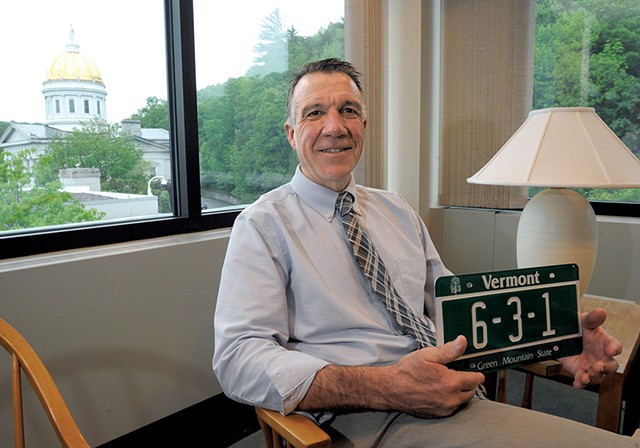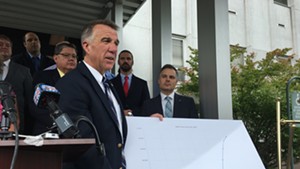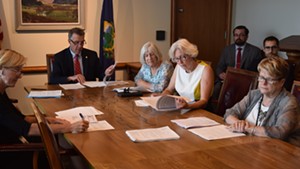
- Jeb Wallace-brodeur
- Gov. Phil Scott
Gov. Phil Scott leaned casually against the desk in his ceremonial Statehouse office last month, fielding questions from reporters about the final days of Vermont's legislative session. Near the end of the impromptu press conference, one journalist asked whether he supported a bill requiring workplace accommodations for pregnant women.
"I think if we're serious about this six, three and one problem that we have ... then we're going to have to grow families," the governor said. "So if we can [make] accommodations to do so, that's all good."
Scott didn't have to explain the numerical code to reporters. Over the previous month and a half, he'd repeatedly invoked "this six, three and one problem" during his public appearances. A week after the press conference, Scott would tell the legislature during his end-of-session address, "These numbers literally keep me up at night." They are so important to his administration that they're emblazoned on a gleaming Vermont license plate hanging above the entryway to Scott's Statehouse office.
So what do they mean?
According to the governor, Vermont loses six workers and three students per day. And, on average, one baby is born to an opiate-addicted mother every 24 hours, he says.
The numbers are shorthand for Scott's focus on spurring economic growth, reducing K-12 education spending and protecting "the most vulnerable." But the governor and his staff say "six-three-one" is more than a catchphrase; it's a lodestar for the entire executive branch — and the basis upon which Scott makes policy decisions.
"We look at everything through that prism," said Scott's chief of staff, Jason Gibbs. "How will it affect 'six-three-one'?"
Scott began speaking publicly about "six-three-one" in late March, but Gibbs said members of the administration had "been talking about this internally for at least the last five months." Before he took office, the governor asked Gibbs and other members of his transition team to craft a boiled-down message.
Since then, according to Scott spokesperson Rebecca Kelley, the numbers "probably come up at just about every cabinet meeting."
The Republican governor's favorite new refrain may be a politically potent rallying cry, but it has also attracted criticism. Experts question the accuracy of Scott's numbers, and top Democrats ask whether the slogan is a good foundation for policy.
"Anybody who has watched the administration this year has seen a very, very policy-lite approach," said Sen. Phil Baruth (D/P-Chittenden). "Mostly what they've done is try to frame things, to be honest, politically." He deemed "six-three-one" "more of the same."
While the mantra may be useful to state employees working in education and public health, it's unclear how it's relevant to a Fish & Wildlife Department game warden or a Department of Motor Vehicles branch employee.
When Senate Majority Leader Becca Balint (D-Windham) broaches the topic with state workers, she said, "I get a lot of eye rolling."
Kelley defended the broad applicability of "six-three-one," offering this hypothetical: If the DMV improves its customer service, she said, it could enhance the quality of life in Vermont, thereby dissuading residents from leaving the state.
"To some extent, you have to simplify your message," Balint conceded. "[But] I feel like there have been a lot of talking points and slogans and simple messages from this administration, and I want more meat."
Then there's the question of whether Scott's stats are accurate — or the best way to measure Vermont's problems. Though the three numbers are presented as current rates, they do not necessarily reflect what is happening in 2017. The numbers are averages calculated for three distinct time periods that extend back as long as 20 years. The labor force actually increased in 2016 after years of decline.
Gibbs admitted that the transition team picked its figures without consulting the agency and department officials it would soon be overseeing.
Seven Days spoke with several of those state workers — as well as outside experts — to check the governor's math.
Six
What the administration says: "In 2010, we had a high of 359,500 people in our workforce, according to the Vermont Department of Labor. In 2016, we had a low of 344,150 ... That's 15,350 fewer in seven years (start of 2010 through end of 2016), which is six fewer each day."
What the experts say: It's not so straightforward, according to Doug Hoffer, who was a policy analyst focusing on economic development before he was elected state auditor in 2012.
"There's no question that the labor force has stagnated and, in some cases, declined," the Democrat/Progressive said, but "the labor force is not the same as jobs."
That's because the former measures the entirety of Vermont's available workforce — those with jobs and those looking for work. From 2010 to 2015, according to the federal Bureau of Labor Statistics, the number of retirement-age residents in Vermont grew by more than 18,000. The primary reason the labor force declined in those years, Hoffer argued, is that people aged out of it — not that they fled the state.
While the labor force lost 15,000 people, Vermont actually gained 15,000 new jobs during the same time period. That means that even though the total pool of available workers shrank, the state has more people working today than it did in 2010 — and a higher share of Vermonters have jobs.
In fact, according to the Bureau of Labor Statistics, Vermont's unemployment rate has dropped from 6.3 percent at the start of 2010 to 3.1 percent as of April 2017, mirroring a nationwide post-recession trend.
"I'm not arguing with the issue of the importance of economic development," Hoffer said. "My only concern is this information, I think, has misled some people who believe ... we're actually losing jobs."
Stephanie Yu, a policy analyst at Vermont's left-leaning Public Assets Institute, agreed that politicians should address the declining labor force. But she pointed out that state Department of Labor data show "that decline bottomed out in January of 2016, and the number in the labor force has been rising again by an average of about 6.5 workers per day."
Gibbs maintained that the six-workers-a-day mantra is a "fair and accurate measurement of the problem" and argued that Scott has been clear that it's based on a multiyear average.
"It's not like anyone in this administration is cherry-picking data to make this problem seem bigger than it is," the chief of staff countered. "It would be downright foolish to look at a few months of 2016 and say the problem has gone away."
Three
What the administration says: "In 1997, we had 103,000 students enrolled in K-12, according to the Agency of Education. At the start of 2017, we had 76,220 students ... That's 26,780 fewer students in 20 years, which is three fewer each day."
What the experts say: "There are lots of ways to count kids," observed the Agency of Education's deputy secretary and chief financial officer, Bill Talbott, who said he didn't know which method the governor used.
Talbott confirmed that the state has lost roughly 27,000 students in its public K-12 system over the last two decades, but he noted that the decline has slowed in recent years. From the 2015-16 school year to the 2016-17 one, the state lost an average of 2.27 students a day.
Rep. David Sharpe (D-Bristol), who chairs the House Education Committee, said he shares the governor's concerns about declining enrollment but thinks Scott has oversimplified the situation.
"He thinks too much money is being spent in K-12 education, and he's using this number of students [lost] to indicate we should have lower costs," Sharpe said. "To some extent, that's true. We should see reduction of staff and per-pupil cost because of that, and we really haven't."
But the number Scott focuses on, Sharpe contends, only gets at part of the cost issue. For instance, "While our number of students may be going down, the percentage of students in poverty is going up," the legislator noted, adding that rising special education expenses are another factor.
"I think the governor has focused on sound bites that are simplistic and appeal to popular concerns, and that has been politically pretty successful. But, policy-wise, I'm not sure," Sharpe said. "I believe that we owe the taxpayers a more thorough understanding of what's going on and better solutions than just slashing budgets."
One
What the administration says: "In 2015, 50.6 babies per 1,000 live births were born exposed to opioids, according to the [Vermont] Department of Health ... VDH estimates about 6,000 live births a year in Vermont. That's 303 babies born exposed to opiates in one year, which is nearly one per day."
What the experts say: Nobody's disputing that Vermont's opiate problem is serious, but Scott's administration is rounding up by 62 infants per year.
Perhaps the better question is whether babies born to opiate-addicted mothers are an appropriate proxy for a crisis that has ravaged Vermonters of all ages and genders.
"We think it's important to point out not just the number, but to point to the reason we have a high number," said Deputy Health Commissioner Barbara Cimaglio.
Part of the explanation, she noted, is actually positive. More providers are aware of the problem, and more women are seeking treatment before giving birth. That typically involves taking the opiate medication methadone, Cimaglio pointed out. Women on methadone have a better chance of giving birth to a healthy baby than those who abruptly stop using beforehand. They're also easier to count.
Is the baby-a-day point at least a useful mantra for Department of Health staff to keep in mind as they try to tackle the problem? "Well, I think it's a population measure, and so certainly we look at that, but we're probably a little more in the weeds," Cimaglio responded.
Dr. Harry Chen, who stepped down from his position as health commissioner in March, noted a different concern with Scott's data point. "I think we have to be very mindful about the stigma piece," he said. "We would absolutely want that number to be zero, but we want to be mindful of how you get to zero."
Chen's point: Focusing on opiate-addicted mothers might reinforce the stigma women experience, which could discourage them from seeking treatment.













Comments (8)
Showing 1-8 of 8
Comments are closed.
From 2014-2020, Seven Days allowed readers to comment on all stories posted on our website. While we've appreciated the suggestions and insights, right now Seven Days is prioritizing our core mission — producing high-quality, responsible local journalism — over moderating online debates between readers.
To criticize, correct or praise our reporting, please send us a letter to the editor or send us a tip. We’ll check it out and report the results.
Online comments may return when we have better tech tools for managing them. Thanks for reading.